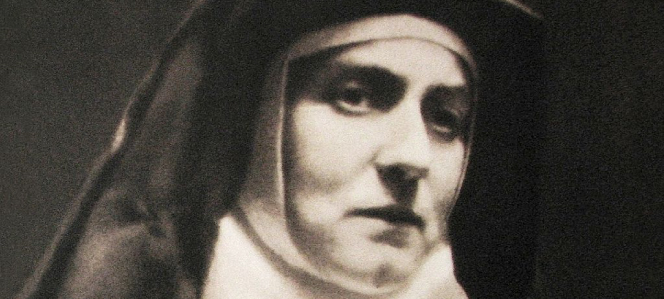St. Edith Stein had been raised Jewish, but fell into atheism as a young woman. After studying under Edmund Husserl, the father of phenomenology, and obtaining her doctorate from the University of Göttingen, she converted to Roman Catholicism and contributed greatly to both philosophy and theology by connecting phenomenology with classical Thomism. After her conversion she joined the Carmelites only to be arrested and executed by the Nazis.
Bishop Barron writes about the example and witness of St. Edith Stein, also called St. Teresa Benedicta a Cruce (Teresa, Blessed by the Cross), in his book Catholicism. Here is an excerpt from the book on her conversion, and an excerpt describing her martyrdom.
“[A] turning point occurred while Edith was strolling with a friend through the old section of Frankfurt. They chanced upon the cathedral, and the two women entered the building as tourists, intent on admiring the architecture. Edith spied a woman, fresh from her rounds of shopping, kneeling in the empty church, obviously lost in prayer. She had certainly seen people at prayer in the synagogue during services, but she had never seen anything like this communion with a presence personal and yet unseen. “I could not forget that,” she wrote. Edith Stein’s conversion was not like Paul’s, sudden and dramatic. It was more like Augustine’s or John Henry Newman’s: gradual, interior, accompanied by a good deal of intellectual wrestling. One night, while staying with friends outside Freiburg, Edith searched through their library looking for something to divert her for the evening. She came upon Saint Teresa of Avila’s autobiography. She took the book off the shelf and stayed up all night reading it. The next morning she put down the test and declared simply, “That is the truth.” What precisely impressed her about the book is impossible to say. When pressed on the matter later, Edith replied, “secretum meum mihi” (that is my secret). It seems fair to conclude that the reading of Teresa’s Life was that galvanizing moment, the occasion for all of the strands to come together.
After a few weeks of reading and praying, Edith approached the local priest and asked to be received into the church. When he balked, due to her recent conversion, she said, “Prufen-sie mich!” (Test me!). She was baptized on January 1, 1922, in those days, the Feast of the Circumcision, the first shedding of Jesus’ blood…
In November of the same year [of her becoming a Carmelite nun in 1934] Kristallnacht (the Night of Broken Glass) took place, and suddenly Jews all over Germany were in acute danger. Concerned for her safety, Edith’s superiors transferred her from the Carmel in Germany to the Carmel of Echt in Holland. But just two years later the Nazis overran Holland, and Edith was once again threatened. Bravely the Dutch Catholic bishops raised their voices in protest over the ill treatment of Jews in their country. The Archbishop of Utrecht went so far as to order that a condemnation of the Nazi policy be read publicly from every pulpit in the country. The Germans retaliated brutally, ordering a roundup of all Jews in Holland who had converted to Catholicism. On Sunday August 2, 1942, the Gestapo came for Edith and her sister, who had joined Edith in the convent. Amid the confusion, anxiety, and raised voices, Edith calmly said, “Come, Rosa, we’re going for our people.” The sisters were held briefly in a camp in Holland and then were packed onto what amounted to a cattle car for the trip to Auschwitz. A former student of Edith’s reported an encounter with the nun when the train stopped briefly at a platform in Germany. After greeting her, Edith asked her to convey a message to the mother superior in Echt: “We are going to the East,” a sentence with both aliteral and a spiritual meaning. She was undoubtedly trying to communicate information about their geographical destination, but “the East” is also mystical language for heaven and eternal life…
On August 9, 1942, Edith arrived at the death camp of Auschwitz-Birkenau. She was selected for immediate execution. The guards brought her to a crude barracks where she was forced to remove her clothes, and then to a small execution chamber where she was murdered by poison gas. Subsequently, her body was placed in a pit and burned—and the ashes strewn to the wind. The classical moral philosophers spoke of courage as the virtue that enables one to do the good despite external threats. What we see in a martyr such as Edith Stein is not ordinary courage but courage elevated and transfigured through love. We see a willingness to give away even one’s life out of love for Christ and his people.”
Join us, on this feast of St. Edith Stein, as we pray for the same courage and love she displayed:
Lord, God of our fathers, You brought St. Teresa Benedicta to the fullness of the science of the Cross at the hour of her martyrdom. Fill us with the same knowledge; and, through her intercession, allow us always to seek after You, the Supreme Truth, and to remain faithful until death to the covenant of love ratified in the blood of Your Son for the salvation of all men and women. We ask these things through Christ, Our Lord. Amen.
